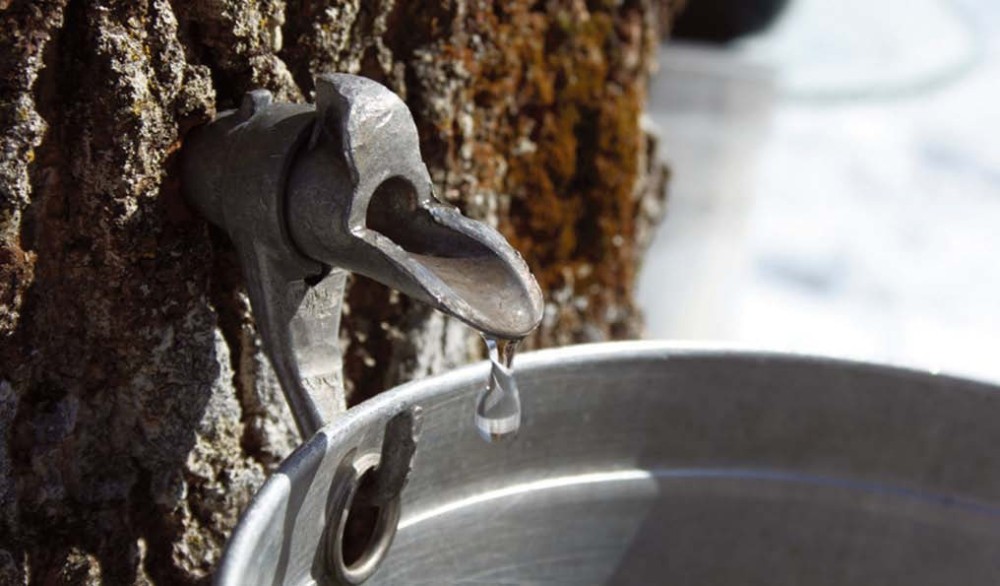Sugarmakers begin drilling holes and hammering spouts into their maple trees at their own discretion, and each has particular schedules and reasons for tapping when they do. Still, the traditional time for tapping has always been right around the first of March, at least in northern New England. But this is changing. Just as we’ve seen long-standing sugaring traditions like buckets and horses give way to newer conventions like plastic tubing and vacuum systems, we’ve also begun to see changes in the traditional sugaring tapping schedule.
Sugaring operations come in all kinds and sizes – from a few reused milk jugs the kids hang on driveway maples to imposing, sophisticated operations with tens of thousands of taps. Regardless of scale, though, all sugarmakers want to be tapped and ready in time to catch the best sap runs. Nobody wants to tap too late and miss out on a gusher. And yet many do. When Tim Wilmot, the University of Vermont Extension Maple Specialist, asks sugarmakers at the end of each year about what they wish they’d done differently, by far the most common response is that they wished they had tapped earlier.
Why did they wait? Because tapping too early has always been regarded as dangerous. The traditional fear is that early tapped holes might “dry out” and give less sap when good sugaring weather arrives many weeks later. And so many sugarmakers agonize over the when-to-tap question during every warm spell in early February.
For large-scale sugarmakers with many tens of thousands of taps, however, there’s not much choice. It takes them weeks or even months to be fully tapped and ready; they can’t afford to wait until March. Thus many of them break with tradition, tapping as early as mid-January.
This all begs some important questions: Do early season tapholes actually dry out earlier than March-drilled ones? And what tapping start date gives a sugarmaker the greatest sap volume for a season?
Tim Wilmot designed experiments to address those fundamental questions. At UVM’s Proctor Maple Research Center in Underhill, Vermont, Wilmot divided maple trees into three groups according to when they were tapped – early, traditional, late – and then compared the volume of sap collected from each category over several years. He did so using both gravity and vacuum-based collecting systems, both being commonly used by sugarmakers.
The tapholes in Wilmot’s earliest group were a month older than those in his traditional group, yet at the end of the year, sap yields were very similar. “We have learned that you can tap in January and it doesn’t diminish your eventual sap yield,” said Wilmot. “The experiments showed that while tapping early did not appear to hurt overall sap yields, neither did it supplement them.”
As to “drying out,” Wilmot explains that the term is not entirely accurate. What happens is that a great variety of fungi, bacteria, and yeasts live in maple forests and they flourish as temperatures rise. Such microbes inevitably infect the tapholes, interacting with the sap inside to form a gummy substance that blocks further sap flow. They don’t really dry out, but they do give less sap when infected.
Wilmot explained that microbial infection is a late season problem: “January and February thaws may allow sap flow but rarely involve the prolonged warmth seen in April.” Accordingly, microorganisms don’t cause as much blockage in the colder, early season but are a significant factor toward the end of the season. As Wilmot reported, “Under both gravity and vacuum, sap flow from tapholes drilled in January and February was comparable to sap flow from much fresher holes during the cooler part of the sap flow season.” But, he cautioned, “Toward the end of the season, when temperatures had exceeded 50oF on several days, January and February tapholes yielded less sap than newer ones.”
Wilmot interprets all this to mean that there can be benefits to getting out in the sugar woods and tapping early because those late season reductions in flow from older tapholes may be compensated for by capture of early-season flows. “In years when many of the sap flow periods involve relatively low temperatures, perhaps 40oF or less, the additional yield from early tapping may provide a significant advantage compared to tapping on March 1.”



Discussion *